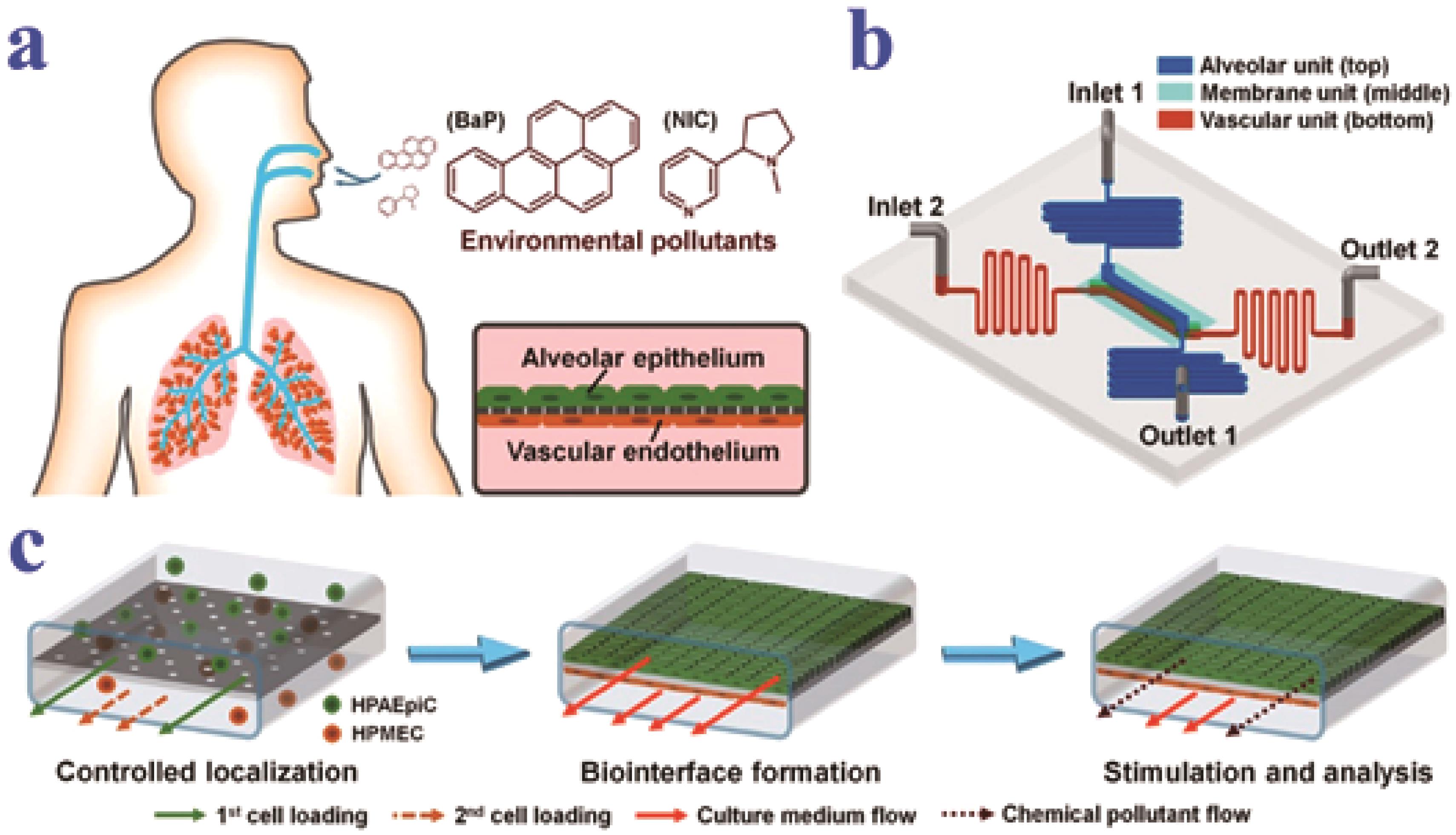
应用化学 ›› 2022, Vol. 39 ›› Issue (1): 18-34.DOI: 10.19894/j.issn.1000-0518.210446
仿生器官芯片研究进展
- 东南大学生物科学与医学工程学院,生物电子学国家重点实验室,南京 210096
-
收稿日期:2021-09-01接受日期:2021-10-08出版日期:2022-01-01发布日期:2022-01-10 -
通讯作者:赵远锦 -
基金资助:国家重点研发计划(2020YFA0908200);国家自然科学基金(52073060);深圳市基础研究发展计划(JCYJ20190813152616459)
Research Progress on Bioinspired Organs⁃on⁃Chips
SUN Ling-Yu,GUO Jia-Hui,WANG Yu,XU Dong-Yu,ZHAO Yuan-Jin( )
)
- State Key Laboratory of Bioelectronics,School of Biological Science and Medical Engineering,Southeast University,Nanjing 210096,China
-
Received:2021-09-01Accepted:2021-10-08Published:2022-01-01Online:2022-01-10 -
Contact:Yuan-Jin ZHAO -
About author:yjzhao@seu.edu.cn
-
Supported by:the National Key Research and Development Program of China(2020YFA0908200);the National Natural Science Foundation of China(52073060);Shenzhen Fundamental Research Program(JCYJ20190813152616459)
摘要:
自然界在漫长的进化过程中创造了大量具备优异特性的天然材料,为人工材料的设计和制备以及相关学科的发展提供了源源不断的灵感来源。得益于材料科学和微加工制造工艺的飞速发展,受自然界天然材料启发而构建的仿生材料受到科研界的广泛关注并随之蓬勃发展。基于精细的形貌加工和组分设计,仿生材料已经被赋予自适应、自修复、自清洁以及雾收集等实用的功能。迄今为止,这些性能优越的仿生材料已经在医学、航空航天、生物医学以及日常生活等领域中展现出了良好的应用潜力。尤其是将功能性仿生材料作为生物支架材料进行细胞培养后并进一步集成到微流控芯片中,由此构建出的器官芯片具有小型化、低消耗和提供仿生微环境等优势,有望取代传统的细胞实验和动物实验,成为药物筛选和疾病模型研究的新平台。本文首先介绍了仿生材料的制备以及所获得仿生材料的特性或功能,然后重点总结了仿生材料在器官芯片中的研究进展,最后对该技术目前面临的挑战和未来的改进方向进行了展望。
中图分类号:
引用本文
孙灵钰, 郭佳慧, 汪雨, 许冬雨, 赵远锦. 仿生器官芯片研究进展[J]. 应用化学, 2022, 39(1): 18-34.
SUN Ling-Yu, GUO Jia-Hui, WANG Yu, XU Dong-Yu, ZHAO Yuan-Jin. Research Progress on Bioinspired Organs⁃on⁃Chips[J]. Chinese Journal of Applied Chemistry, 2022, 39(1): 18-34.

图1 (a)基于微流控装置制备异形微球的示意图及生成过程图[17];(b)微流控技术制备螺旋纤维的示意图及不同流速下微纤维的制备过程图[20];(c)利用气液界面自组装的分级结构光子晶体膜在不同形状基底上的明场图[23];(d)自组装胶体晶体模板复制而来的结构色水凝胶补片的黏附性和结构色响应性[24]
Fig.1 (a) Schematic diagram and the formation process of adhesive disc-like microparticles from microfluidics[17]. (b) Scheme and fabrication of helical microfibers from microfluidics with different flow rates[20]. (c) Bright field images of hierarchical photonic crystal films on different shapes of substrates via self-assembly at gas-liquid interface[23]. (d) Adhesive and self-reporting feature of structural color hydrogel patches replicated from self-assembled colloidal crystal templates[24]
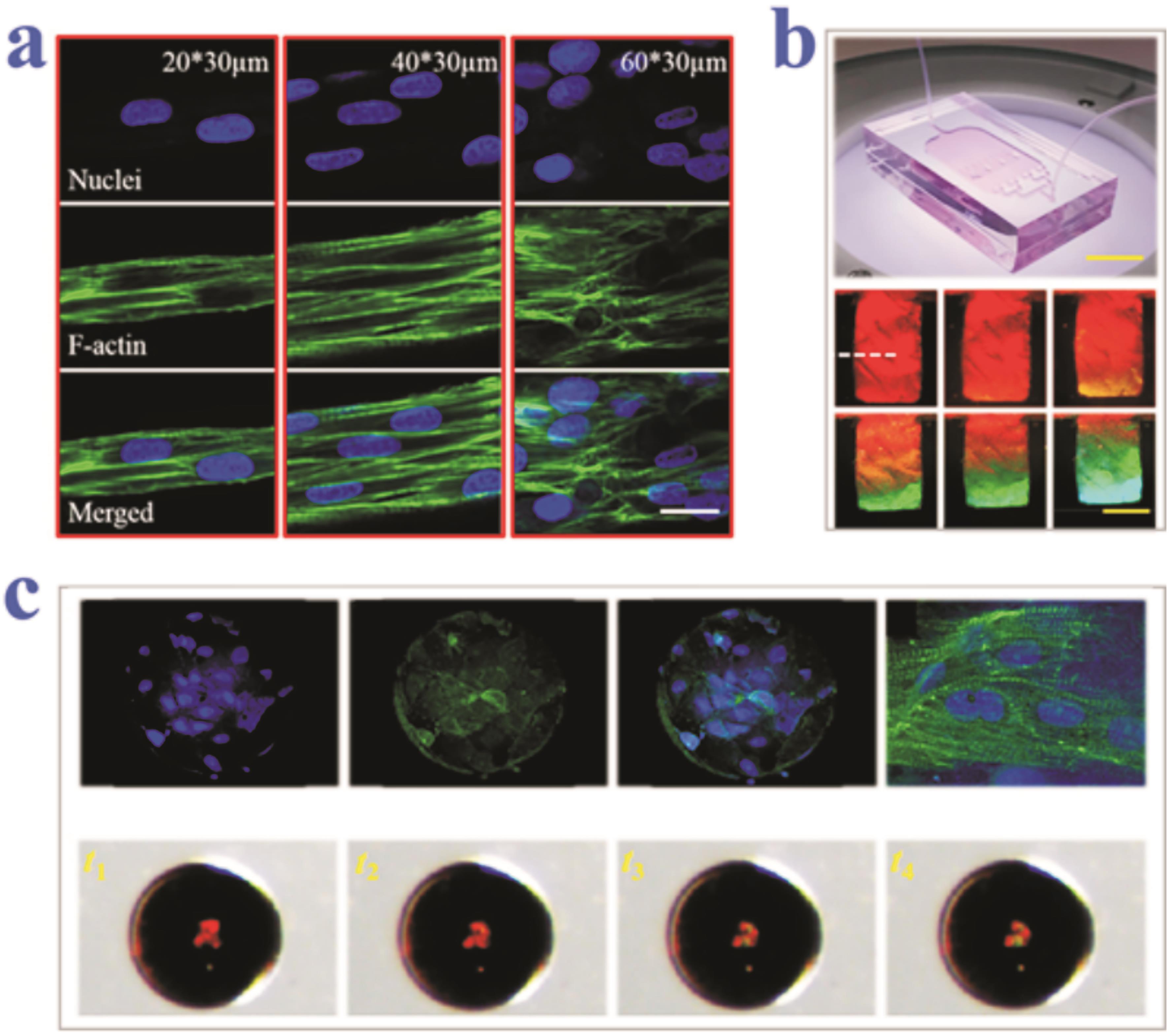
图2 (a)不同宽度的沟槽结构水凝胶膜对于原代心肌细胞的取向诱导荧光图[58];(b)反蛋白石结构薄膜集成的心脏芯片及心肌细胞驱动该薄膜变形过程中的结构色变化[60];(c)心肌细胞在结构色水凝胶微球上的荧光图像以及心肌细胞带动下微球的结构色变化[62]
Fig.2 (a) Fluorescent images showing the alignment of cardiomyocytes on structural color hydrogels with different concave and convex side values[58]. (b) Inverse opal film-integrated heart-on-a-chip and the structural color variation during film deformation process driven by cardiomyocytes[60].. (c) Fluorescent images of cardiomyocytes cultured on an inverse opal microparticle and its structural color change under the actuation of cardiomyocytes[62]
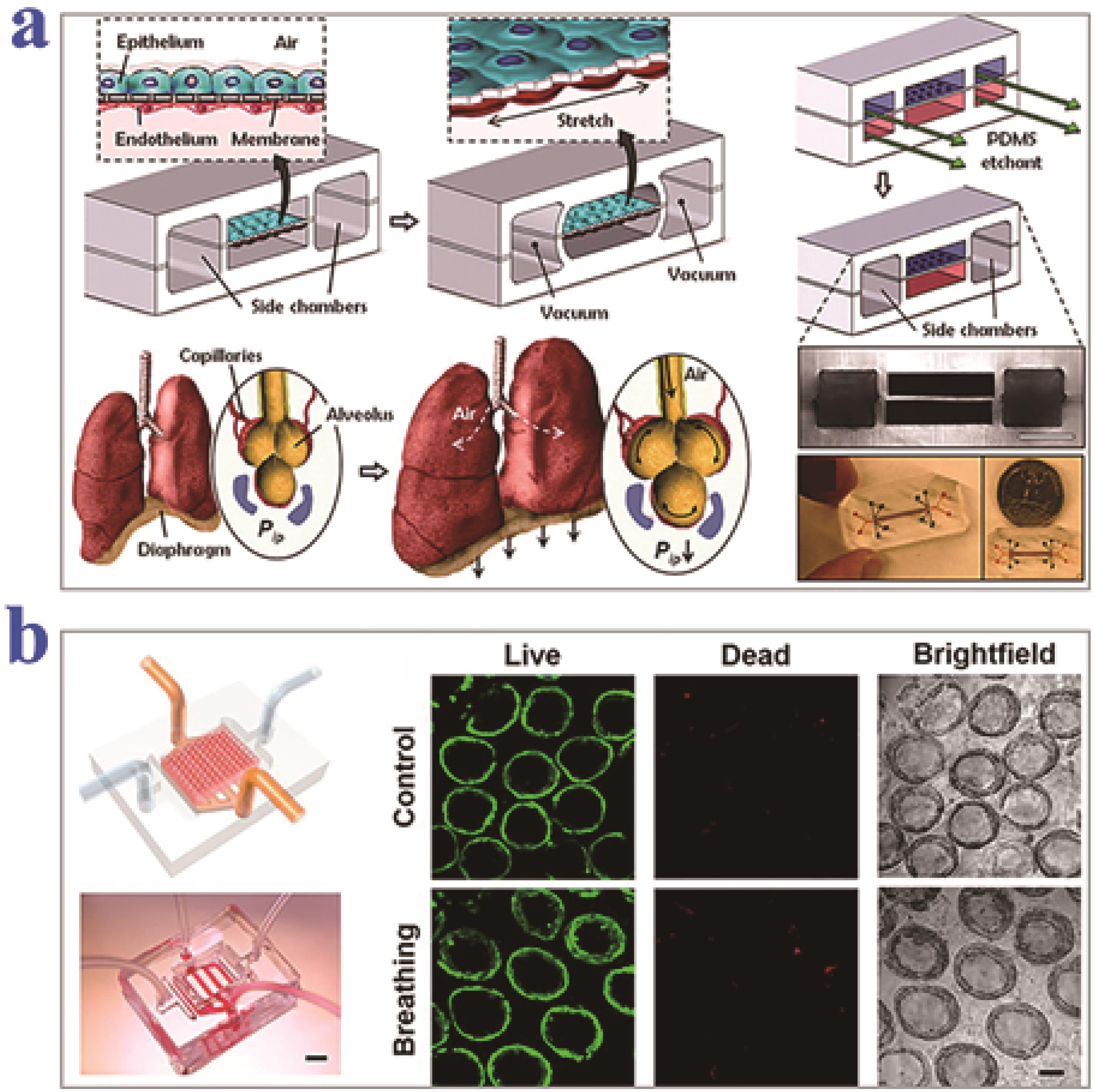
图3 (a)“可呼吸”的人体肺芯片示意图及实物图[66];(b)反蛋白石结构水凝胶支架集成的肺芯片及所培养的内皮细胞在没有/有呼吸情况下的活性对比[67]
Fig.3 (a) Schematic diagram and optical image of a breathable human lung-on-a-chip[66]. (b) A lung-on-a-chip integrated with inverse opal-structured hydrogel scaffold, and the viability comparison between human alveolar epithelial cells that cultured in the chip without or with breathing[67]
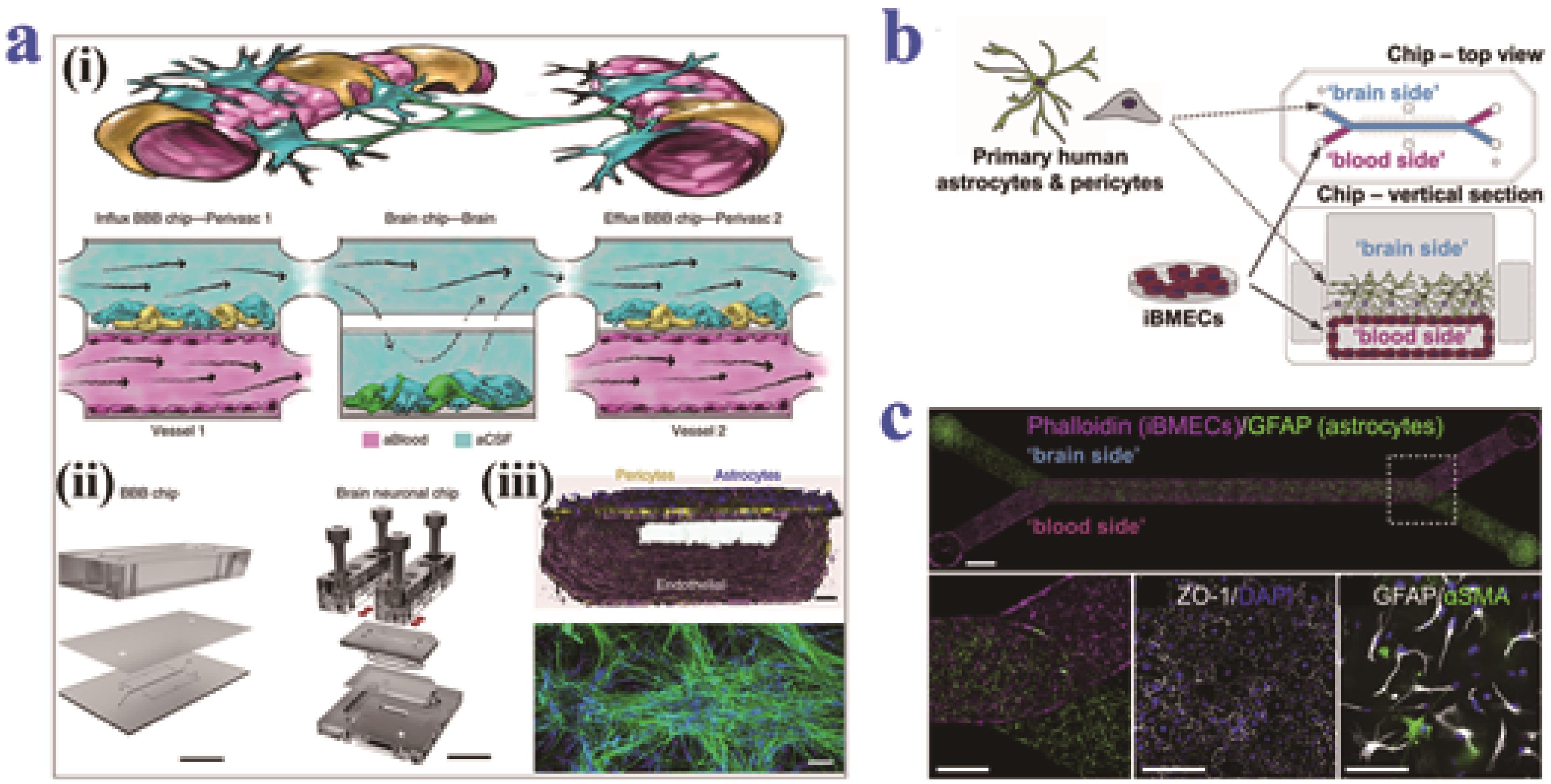
图4 (a)神经血管单元的简化示意图以及血脑屏障-脑实质-血脑屏障装置示意图(i),大脑芯片的设计图(ii)以及芯片内培养的大脑组织的荧光重建图像(iii)[72];(b - c)诱导多能干细胞来源的多细胞系构建的人体血脑屏障芯片[73]
Fig.4 (a) Simplified scheme of neurovascular unit and BBB-brain parenchyma-BBB device (i), optical photograph showing the design of the desired brain chip (ii) and fluorescent 3D reconstruction of the brain tissue cultured in the chip (iii)[72]. (b - c) Construction of a human BBB chip using multiple cells derived from induced pluripotent stem cells[73]
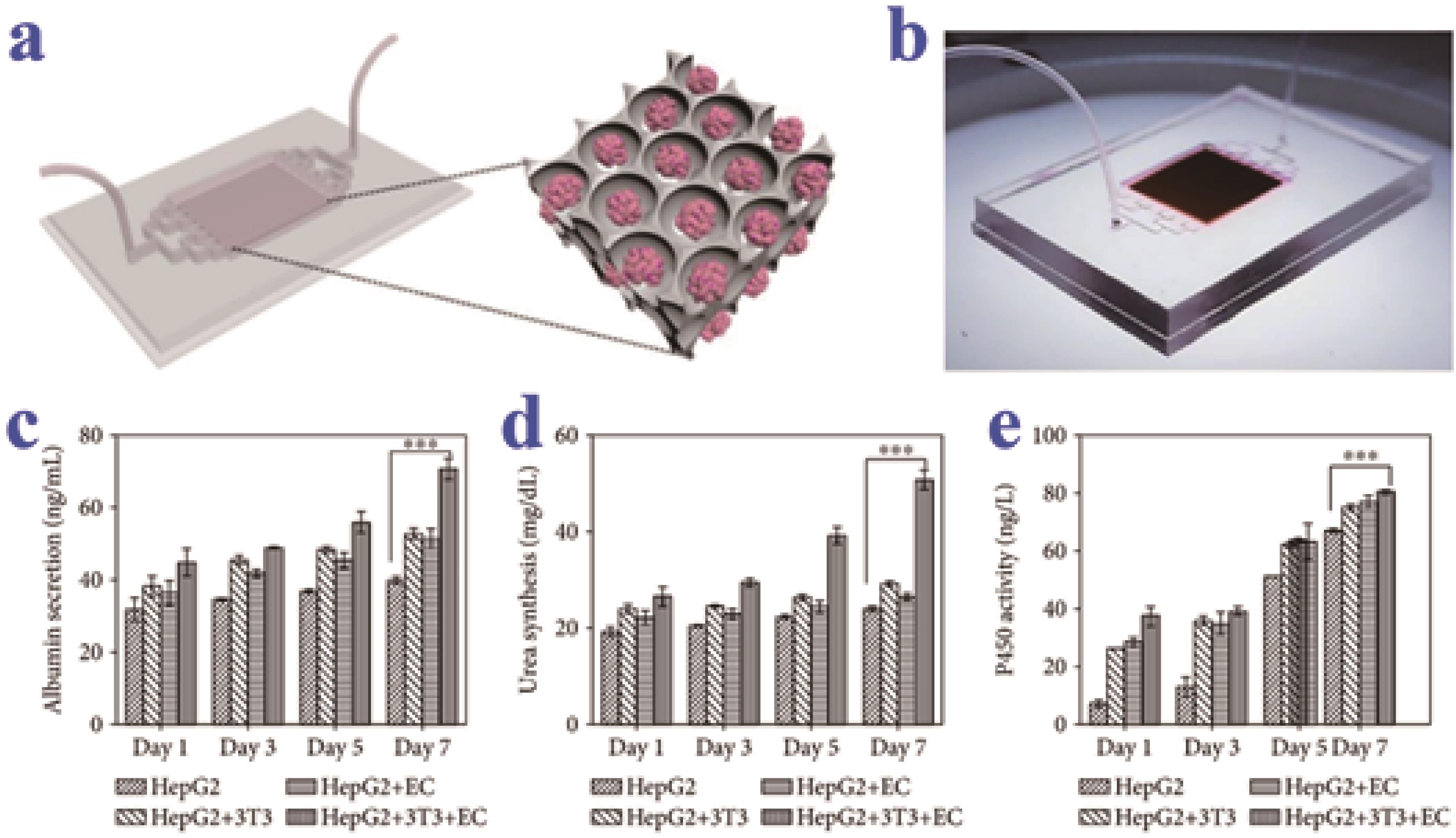
图5 基于响应性反蛋白石结构支架构建的肝脏器官芯片及功能评估[79]:(a)肝脏芯片构建示意图;(b)肝脏芯片实物图;(c - e)分别是不同组别中白蛋白分泌(c)、尿素合成(d)以及细胞色素P450表达水平(e)的数据统计图
Fig.5 A liver-on-a-chip based on responsive scaffolds with responsive feature and its function evaluation[79]: (a) Schematic diagram of the liver-on-a-chip. (b) Optical image of the inverse opal scaffold-integrated liver-on-a-chip. (c - e) Data statistics showing the albumin secretion (c), urea synthesis (d) and cytochrome P450 expression level (e) in different groups, respectively
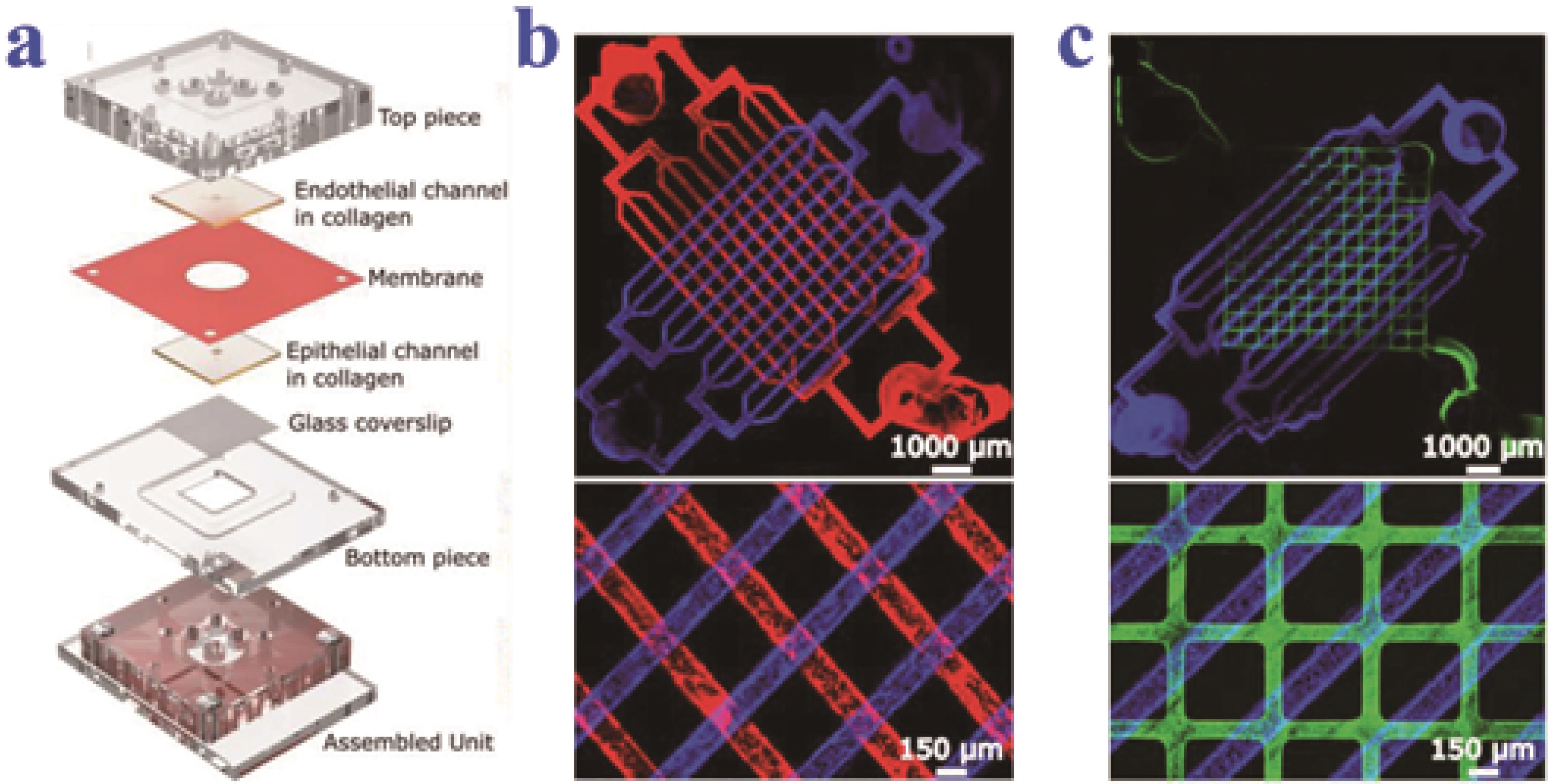
图6 (a)肾脏血管小管单元芯片的设计图;(b和c)该芯片由平行排列的下层通道和平行排列的上层通道(b)或者网格状排列的上层通道(c)所组成[85]
Fig.6 (a) Design of a renal vascular-tubular unit chip. (b, c) The chip was composed of a parallel-channel bottom layer and a parallel-channel (b) or a grid-channel (c) top layer[85]
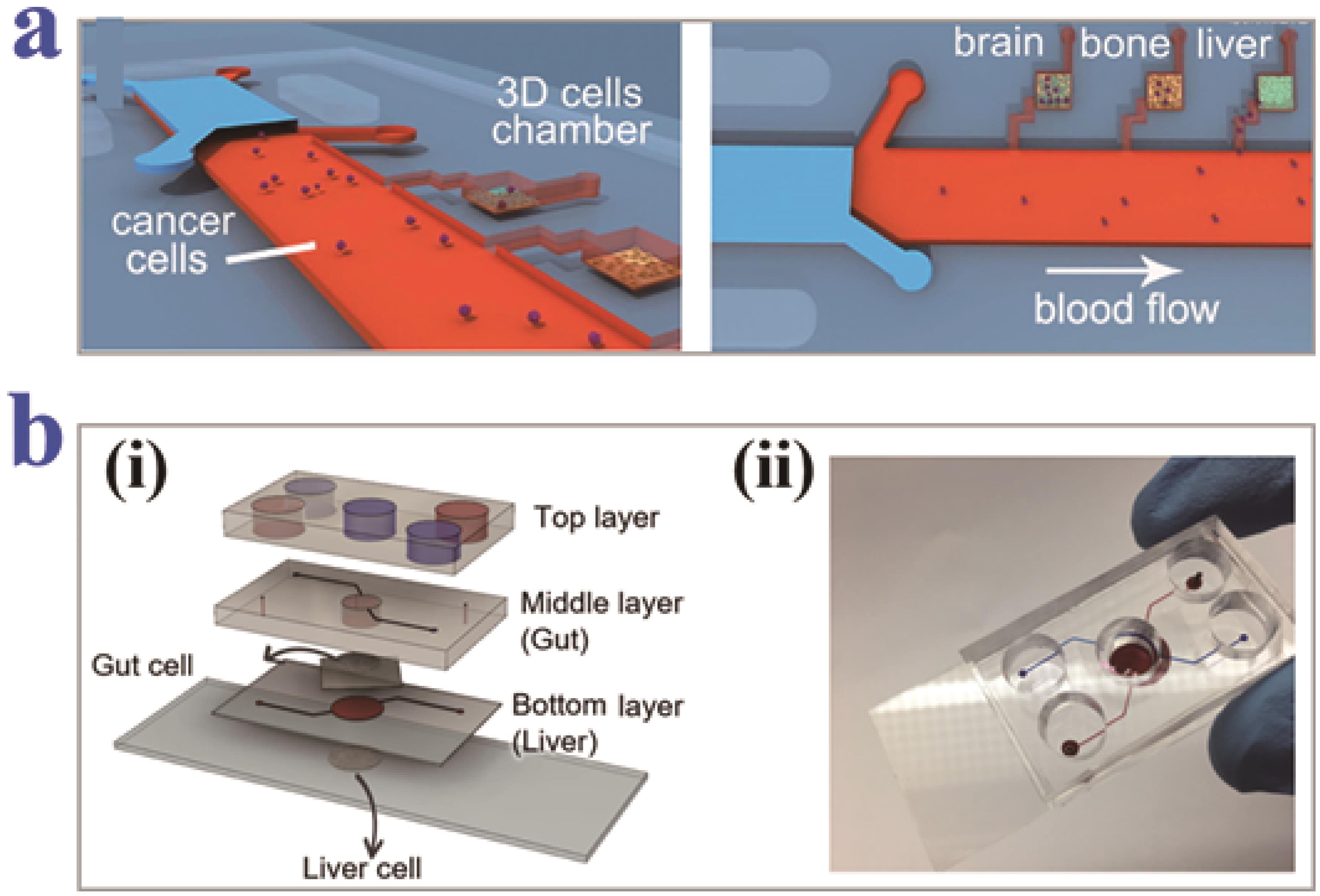
图7 (a)用于模拟肺癌向大脑、骨骼和肝脏器官转移多器官芯片的通道设计[92];(b)肝-肠芯片的(i)设计图及(ii)实物图[94]
Fig.7 (a) Channel design of a multi-organ chip for simulating lung cancer metastasis to the brain, bone and liver[92]. (b) The chip fabrication (i) and optical photograph (ii) of a gut-liver-on-a-chip[94]
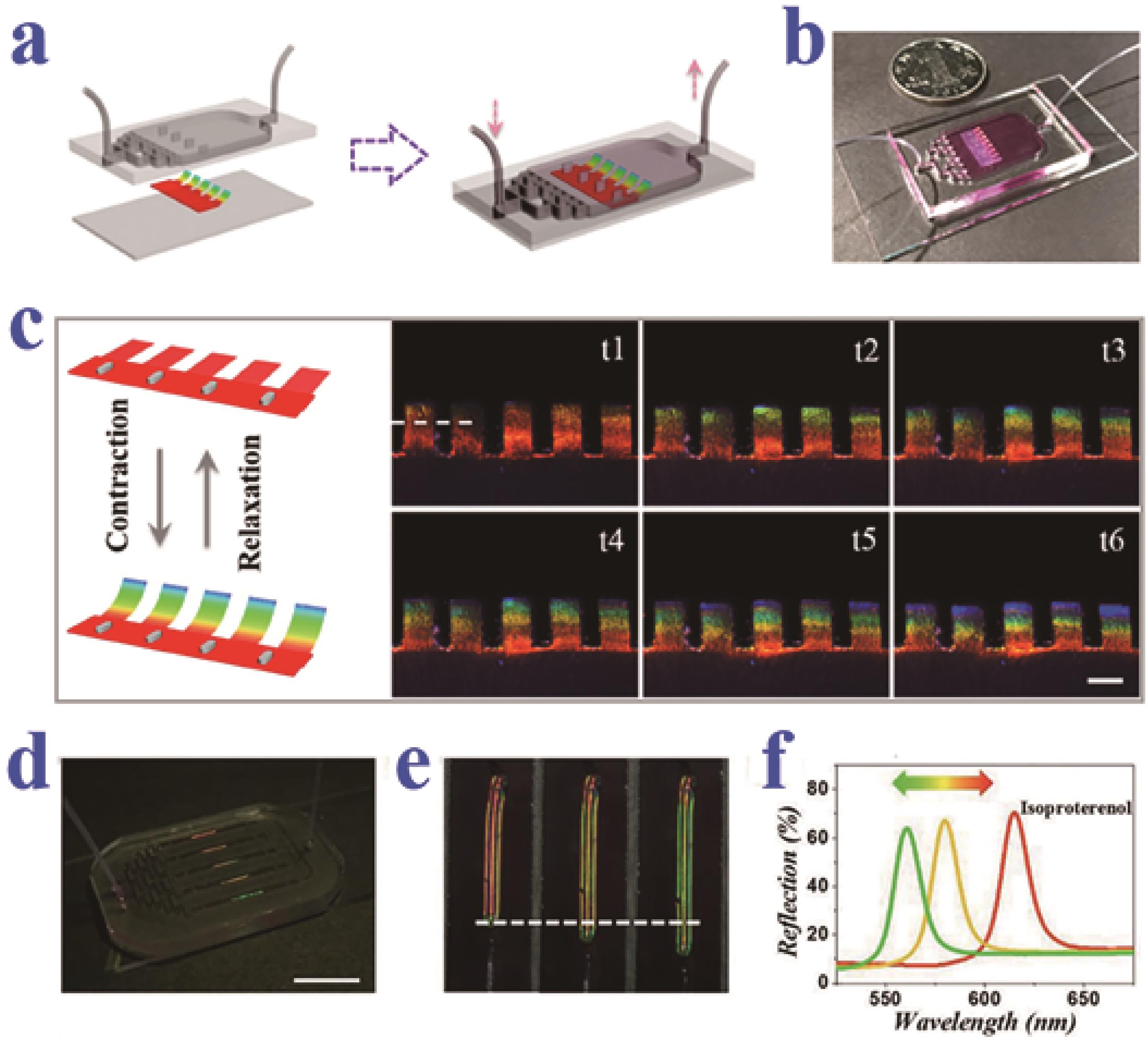
图9 (a–c)基于微条纹结构色水凝胶薄膜的心脏芯片及其在药物评估中的应用[58];(d–f)结构色微纤维集成的多通道心脏芯片用于梯度药物测试[63]
Fig.9 (a–c) Heart-on-a-chip based on micropatterned structural color hydrogel film and its application for drug evaluation[58]. (d–f) Structural color microfiber-integrated multichannel heart-on-a-chip for gradient drug testing[63]
| 1 | WEGST U G K, BAI H, SAIZ E, et al. Bioinspired structural materials[J]. Nat Mater, 2015, 14(1): 23-36. |
| 2 | KONG T, LUO G, ZHAO Y, et al. Bioinspired superwettability micro/nanoarchitectures: fabrications and applications[J]. Adv Funct Mater, 2019, 29(11): 1808012. |
| 3 | LI R, FAN X, LIU Z, et al. Smart bioinspired nanochannels and their applications in energy-conversion systems[J]. Adv Mater, 2017, 29(45): 1702983. |
| 4 | KIM T, SEE C W, LI X C, et al. Orthopedic implants and devices for bone fractures and defects: past, present and perspective[J]. Eng Regener, 2020, 1: 6-18. |
| 5 | 张青, 戴起勋, 赵玉涛, 等. 仿生材料设计与制备的研究进展[J]. 江苏大学学报(自然科学版), 2003, 24(6): 55-60. |
| ZHANG Q, DAI Q X, ZHAO Y T, et al. Progress in design and fabrication of biomimetic material[J]. J Jiangsu Univ (Nat Sci Ed), 2003, 24(6): 55-60. | |
| 6 | MAZZOLAI B, LASCHI C. A vision for future bioinspired and biohybrid robots[J]. Sci Robot, 2020, 5(38): eaba6893. |
| 7 | SABU C, REJO C, KOTTA S, et al. Bioinspired and biomimetic systems for advanced drug and gene delivery[J]. J Control Release, 2018, 287: 142-155. |
| 8 | CAPLIN J D, GRANADOS N G, JAMES M R, et al. Microfluidic organ-on-a-chip technology for advancement of drug development and toxicology[J]. Adv Healthcare Mater, 2015, 4(10): 1426-1450. |
| 9 | CHEN X, ZHANG Y S, ZHANG X, et al. Organ-on-a-chip platforms for accelerating the evaluation of nanomedicine[J]. Bioact Mater, 2021, 6(4): 1012-1027. |
| 10 | ZHANG B, KOROLJ A, LAI B F L, et al. Advances in organ-on-a-chip engineering[J]. Nat Rev Mater, 2018, 3(8): 257-278. |
| 11 | SHANG L, CHENG Y, ZHAO Y. Emerging droplet microfluidics[J]. Chem Rev, 2017, 117(12): 7964-8040. |
| 12 | CHENG Y, ZHENG F, LU J, et al. Bioinspired multicompartmental microfibers from microfluidics[J]. Adv Mater, 2014, 26(30): 5184-5190. |
| 13 | CAI L, WANG H, YU Y, et al. Stomatocyte structural color-barcode micromotors for multiplex assays[J]. Natl Sci Rev, 2020, 7(3): 644-651. |
| 14 | GUO J, YU Y, ZHANG D, et al. Morphological hydrogel microfibers with MXene encapsulation for electronic skin[J]. Research, 2021, 2021: 7065907. |
| 15 | WANG J, LE-THE H, WANG Z, et al. Microfluidics assisted fabrication of three-tier hierarchical microparticles for constructing bioinspired surfaces[J]. ACS Nano, 2019, 13(3): 3638-3648. |
| 16 | SUN L, BIAN F, WANG Y, et al. Bio-inspired programmable wettability arrays for droplets manipulation[J]. Proc Natl Acad Sci USA, 2020, 117(9), 4527-4532. |
| 17 | CAI L, CHEN G, WANG Y, et al. Boston ivy-inspired disc-like adhesive microparticles for drug delivery[J]. Research, 2021, 2021: 9895674. |
| 18 | CHENG Y, ZHU C, XIE Z, et al. Anisotropic colloidal crystal particles from microfluidics[J]. J Colloid Interface Sci, 2014, 421: 64-70. |
| 19 | SHANG L, WANG Y, YU Y, et al. Bio-inspired stimuli-responsive graphene oxide fibers from microfluidics[J]. J Mater Chem A, 2017, 5(29): 15026-15030. |
| 20 | YU Y, FU F, SHANG L, et al. Bioinspired helical microfibers from microfluidics[J]. Adv Mater, 2017, 29(18): 1605765. |
| 21 | GOERLITZER E S A, KLUPP TAYLOR R N, VOGEL N. Bioinspired photonic pigments from colloidal self-assembly[J]. Adv Mater, 2018, 30(28): 1706654. |
| 22 | WU Z, LIN X, SI T, et al. Recent progress on bioinspired self-propelled micro/nanomotors via controlled molecular self-assembly[J]. Small, 2016, 12(23): 3080-3093. |
| 23 | ZHANG L, SUN L, ZHANG Z, et al. Bioinspired superhydrophobic surface by hierarchically colloidal assembling of microparticles and colloidal nanoparticles[J]. Chem Eng J, 2020, 394: 125008. |
| 24 | WANG Y, SHANG L, CHEN G, et al. Bioinspired structural color patch with anisotropic surface adhesion[J]. Sci Adv, 2020, 6(4): eaax8258. |
| 25 | HE C, YE T, TENG W, et al. Bioinspired shear-flow-driven layer-by-layer in situ self-assembly[J]. ACS Nano, 2019, 13(2): 1910-1922. |
| 26 | CONTE M P, LAU K H A, ULIJIN R V. Biocatalytic self-assembly using reversible and irreversible enzyme immobilization[J]. ACS Appl Mater Interfaces, 2017, 9(4): 3266-3271. |
| 27 | LI T, CHANG J, ZHU Y, et al. 3D printing of bioinspired biomaterials for tissue regeneration[J]. Adv Healthcare Mater, 2020, 9(23): 2000208. |
| 28 | WANG D, CHEN D, CHEN Z. Recent progress in 3D printing of bioinspired structures[J]. Front Mater, 2020, 7: 286. |
| 29 | YAN C, JIANG P, JIA X, et al. 3D printing of bioinspired textured surfaces with superamphiphobicity[J]. Nanoscale, 2020, 12(5): 2924-2938. |
| 30 | LIU X, GU H, WANG M, et al. 3D printing of bioinspired liquid superrepellent structures[J]. Adv Mater, 2018,30(22): 1800103. |
| 31 | VANAEI S, PARIZI M S, SALEMIZADEHPARIZI F, et al. An overview on materials and techniques in 3D bioprinting toward biomedical application[J]. Eng Regener, 2021, 2: 1-18. |
| 32 | LI X, SHAN W, YANG Y, et al. Limpet tooth-inspired painless microneedles fabricated by magnetic field-assisted 3D printing[J]. Adv Funct Mater, 2021, 31(5): 2003725. |
| 33 | WANG H, HUANG Z, LI J, et al. Design of 3D printed bioinspired nacre-like structured materials with significantly enhanced thermal conductivity[J]. Appl Phys Lett, 2021, 118: 131903. |
| 34 | LIU L, LIU S, SCHELP M, et al. Rapid 3D printing of bioinspired hybrid structures for high-efficiency fog collection and water transportation[J]. ACS Appl Mater Interfaces 2021, 13(24): 29122-29129. |
| 35 | LEE H, HAN W, KIM H, et al. Development of liver decellularized extracellular matrix bioink for three-dimensional cell printing-based liver tissue engineering[J]. Biomacromolecules, 2017, 18(4): 1229-1237. |
| 36 | KIM B S, KWON Y W, KONG J S, et al. 3D cell printing of in vitro stabilized skin model and in vivo pre-vascularized skin patch using tissue-specific extracellular matrix bioink: a step towards advanced skin tissue engineering[J]. Biomaterials, 2018, 168: 38- 53. |
| 37 | JANG J, PARK J Y, GAO G, et al. Biomaterials-based 3D cell printing for next-generation therapeutics and diagnostics[J]. Biomaterials, 2018, 156: 88-106. |
| 38 | KIM J, KONG J S, HAN W, et al. 3D cell printing of tissue/organ-mimicking constructs for therapeutic and drug testing applications[J]. Int J Mol Sci, 2020, 21(20): 7757. |
| 39 | KUANG X, ROACH D J, WU J, et al. Advances in 4D printing: materials and applications[J]. Adv Funct Mater, 2019, 29(2): 1805290. |
| 40 | VELASCO-HOGAN A, XU J, MEYERS M A. Additive manufacturing as a method to design and optimize bioinspired structures[J]. Adv Mater, 2018, 30(52): 1800940. |
| 41 | LEE A Y, AN J, CHUA C K. Two-way 4D printing: a review on the reversibility of 3D-printed shape memory materials[J]. Engineering, 2017, 3(5): 663-674. |
| 42 | ZHANG B, ZHANG W, ZHANG Z, et al. Self-healing four-dimensional printing with an ultraviolet curable double-network shape memory polymer system[J] ACS Appl Mater Interfaces, 2019, 11(10): 10328-10336. |
| 43 | JU J, XIAO K, YAO X, et al. Bioinspired conical copper wire with gradient wettability for continuous and efficient fog collection[J]. Adv Mater, 2013, 25(41): 5937-5942. |
| 44 | MA Z C, LI C H, HU X Y, et al. Laser fabrication of bioinspired graphene surfaces with superwettability[J]. Front Chem, 2020, 8: 525. |
| 45 | COBURN J M, GIBSON M, MONAGLE S, et al. Bioinspired nanofibers support chondrogenesis for articular cartilage repair[J]. Proc Natl Acad Sci USA, 2012, 109(25): 10012-10017. |
| 46 | SHAO J Y, CHEN X L, LI X M, et al. Nanoimprint lithography for the manufacturing of flexible electronics[J]. Sci China Technol Sci, 2019, 62(2): 175-198. |
| 47 | SUN J, BHUSHAN B. Nanomanufacturing of bioinspired surfaces[J]. Tribol Int, 2019, 129: 67-74. |
| 48 | MA C, PENG Y, LI H, et al. Organ-on-a-chip: a new paradigm for drug development[J]. Trends Pharmacol Sci, 2021, 42(2), 119-133. |
| 49 | 陈超瑜, 马妍, 方群. 微流控器官芯片的研究进展[J]. 分析化学, 2019, 47(11): 1711-1720. |
| CHEN C Y, MA Y, FANG Q. Advances in microfluidic organ-on-a-chip systems[J]. Chinese J Anal Chem, 2019, 47(11): 1711- 1720. | |
| 50 | KITSARA M, KONTZIAMPASIS D, AGBULUT O, et al. Heart on a chip: micro-nanofabrication and microfluidics steering the future of cardiac tissue engineering[J]. Microelectron Eng, 2019, 203: 44-62. |
| 51 | 陈颖, 付炜. 心脏芯片研究进展[J]. 组织工程与重建外科, 2021, 17(1): 66-69. |
| CHEN Y, FU W. Research progress of microfluidic heart on a chip[J]. J Tissue Eng Reconstr Surg, 2021, 17(1): 66-69. | |
| 52 | ZHANG X, WANG T, WANG P, et al. High-throughput assessment of drug cardiac safety using a high-speed impedance detection technology-based heart-on-a-chip[J]. Micromachines, 2016, 7(7): 122. |
| 53 | AGARWAL A, GOSS J A, CHO A, et al. Microfluidic heart on a chip for higher throughput pharmacological studies[J]. Lab Chip, 2013, 13(18): 3599-3608. |
| 54 | REN L, ZHOU X, NASIRI R, et al. Combined effects of electric stimulation and microgrooves in cardiac tissue-on-a-chip for drug screening[J]. Small Methods, 2020, 4(10): 2000438. |
| 55 | SHANG Y, CHEN Z, ZHANG Z, et al. Heart-on-chips screening based on photonic crystals[J]. Bio-des Manuf, 2020, 3(3): 266-280. |
| 56 | CHEN Z, FU F, YU Y, et al. Cardiomyocytes-actuated morpho butterfly wings[J]. Adv Mater, 2019, 31(8): 1805431. |
| 57 | LI L, CHEN Z, SHAO C, et al. Graphene hybrid anisotropic structural color film for cardiomyocytes' monitoring[J]. Adv Funct Mater, 2020, 30(3): 1906353. |
| 58 | FU F, SHANG L, CHEN Z, et al. Bioinspired living structural color hydrogels[J]. Sci Robot ,2018, 3(16): eaar8580. |
| 59 | GONG Y, CHEN Z, YANG L, et al. Intrinsic color sensing system allows for real-time observable functional changes on human induced pluripotent stem cell-derived cardiomyocytes[J]. ACS Nano, 2020, 14(7): 8232-8246. |
| 60 | SHANG Y, CHEN Z, FU F, et al. Cardiomyocyte-driven structural color actuation in anisotropic inverse opals[J]. ACS Nano, 2018, 13(1): 796-802. |
| 61 | SUN L, CHEN Z, BIAN F, et al. Bioinspired soft robotic caterpillar with cardiomyocyte drivers[J]. Adv Funct Mater, 2020, 30(6): 1907820. |
| 62 | WANG H, LIU Y, CHEN Z, et al. Anisotropic structural color particles from colloidal phase separation[J]. Sci Adv, 2020, 6(2): eaay1438. |
| 63 | CHEN Z, YU Y, GUO J, et al. Heterogeneous structural color microfibers for cardiomyocytes tug-of-war[J]. Adv Funct Mater, 2021, 31(9): 2007527. |
| 64 | SUN L, YU Y, CHEN Z, et al. Biohybrid robotics with living cell actuation[J]. Chem Soc Rev, 2020, 49(12): 4043-4069. |
| 65 | HUH D. A human breathing lung-on-a-chip[J]. Ann Am Thorac Soc, 2015, 12(Suppl 1): S42-S44. |
| 66 | HUH D, MATTHEWS B D, MAMMOTO A, et al. Reconstituting organ-level lung functions on a chip[J]. Science, 2010, 328(5986): 1662-1668. |
| 67 | HUANG D, LIU T, LIAO J, et al. Reversed-engineered human alveolar lung-on-a-chip model[J]. Proc Natl Acad Sci USA, 2021, 118(19): e2016146118. |
| 68 | STAICU C E, JIPA F, AXENTE E, et al. Lab-on-a-chip platforms as tools for drug screening in neuropathologies associated with blood-brain barrier alterations[J]. Biomolecules, 2021, 11(6): 916. |
| 69 | BANG S, JEONG S, CHOI N, et al. Brain-on-a-chip: a history of development and future perspective[J]. Biomicrofluidics, 2019, 13(5): 051301. |
| 70 | PARK T E, MUSTAFAOGLU N, HERLAND A, et al. Hypoxia-enhanced blood-brain barrier chip recapitulates human barrier function and shuttling of drugs and antibodies[J]. Nat Commun, 2019, 10(1): 1-12. |
| 71 | KIM J A, KIM H N, IM S K, et al. Collagen-based brain microvasculature model in vitro using three-dimensional printed template[J]. Biomicrofluidics, 2015, 9(2): 024115. |
| 72 | MAOZ B M, HERLAND A, FITZGERALD E A, et al. A linked organ-on-chip model of the human neurovascular unit reveals the metabolic coupling of endothelial and neuronal cells[J]. Nat Biotechnol, 2018, 36(9): 865-874. |
| 73 | VATINE G D, BARRILE R, WORKMAN M J, et al. Human iPSC-derived blood-brain barrier chips enable disease modeling and personalized medicine applications[J]. Cell Stem Cell, 2019, 24(6): 995-1005. |
| 74 | YI H G, JEONG Y H, KIM Y, et al. A bioprinted human-glioblastoma-on-a-chip for the identification of patient-specific responses to chemoradiotherapy[J]. Nat Biomed Eng, 2019, 3(7): 509-519. |
| 75 | MORADI E, JALILI-FIROOZINEZHAD S, SOLATI-HASHJIN M. Microfluidic organ-on-a-chip models of human liver tissue[J]. Acta Biomater, 2020, 116: 67-83. |
| 76 | DENG J, WEI W, CHEN Z, et al. Engineered liver-on-a-chip platform to mimic liver functions and its biomedical applications: a review[J]. Micromachines, 2019, 10(10): 676. |
| 77 | LEE H, CHAE S, KIM J Y, et al. Cell-printed 3D liver-on-a-chip possessing a liver microenvironment and biliary system[J]. Biofabrication, 2019, 11(2): 025001. |
| 78 | ZHANG Y, YANG N, XIE L, et al. A new 3D cultured liver chip and real-time monitoring system based on microfluidic technology[J]. Micromachines, 2020,11(12): 1118. |
| 79 | SHAO C, LIU Y, CHI J, et al. Responsive inverse opal graphene hydrogel scaffolds with biomimetic enrichment capability for cell culture[J]. Research, 2019, 2019: 9783793. |
| 80 | YA S, DING W, LI S, et al. On-chip construction of liver lobules with self-assembled perfusable hepatic sinusoid networks[J]. ACS Appl Mater Interfaces, 2021, 13(28): 32640-32652. |
| 81 | WANG Y, WANG H, DENG P, et al. Modeling human nonalcoholic fatty liver disease (NAFLD) with an organoids-on-a-chip system[J]. ACS Biomater Sci Eng, 2020,6(10): 5734-5743. |
| 82 | LEE J, KIM K, KIM S. Kidney on chips[J]. Method Cell Biol, 2018, 146: 85-104. |
| 83 | KIM S, TAKAYAMA S. Organ-on-a-chip and the kidney[J]. Kidney Res Clin Pract, 2015, 34(3): 165-169. |
| 84 | CHEN H, BIAN F, SUN L, et al. Hierarchically molecular imprinted porous particles for biomimetic kidney cleaning[J]. Adv Mater, 2020, 32(52): 2005394. |
| 85 | RAYNER S G, PHONG K T, XUE J, et al. Reconstructing the human renal vascular-tubular unit in vitro[J]. Adv Healthcare Mater, 2018, 7(23): 1801120. |
| 86 | MUSAH S, MAMMOTO A, FERRANTE T C, et al. Mature induced-pluripotent-stem-cell-derived human podocytes reconstitute kidney glomerular-capillary-wall function on a chip[J]. Nat Biomed Eng, 2017, 1(5): 1-12. |
| 87 | MUSAH S, DIMITRAKAKIS N, CAMACHO D M, et al. Directed differentiation of human induced pluripotent stem cells into mature kidney podocytes and establishment of a glomerulus chip[J]. Nat Protoc, 2018, 13(7): 1662-1685. |
| 88 | GIJZEN L, YENGEJ F A Y, SCHUTGENS F, et al. Culture and analysis of kidney tubuloids and perfused tubuloid cells-on-a-chip[J]. Nat Protoc, 2021, 16(4): 2023-2050. |
| 89 | WANG J, WANG C, XU N, et al. A virus-induced kidney disease model based on organ-on-a-chip: pathogenesis exploration of virus-related renal dysfunctions[J]. Biomaterials, 2019, 219: 119367. |
| 90 | BAUER S, HULDT C W, KANEBRATT K P, et al. Functional coupling of human pancreatic islets and liver spheroids on-a-chip: towards a novel human ex vivo type 2 diabetes model[J]. Sci Rep, 2017, 7(1): 1-11. |
| 91 | MASCHMEYER I, HASENBERG T, JAENICKE A, et al. Chip-based human liver-intestine and liver-skin co-cultures-a first step toward systemic repeated dose substance testing in vitro[J]. Eur J Pharm Biopharm, 2015, 95: 77-87. |
| 92 | XU Z, LI E, GUO Z, et al. Design and construction of a multi-organ microfluidic chip mimicking the in vivo microenvironment of lung cancer metastasis[J]. ACS Appl Mater Interfaces, 2016, 8(39): 25840-25847. |
| 93 | LIU W, SONG J, DU X, et al. AKR1B10 (Aldo-keto reductase family 1 B10) promotes brain metastasis of lung cancer cells in a multi-organ microfluidic chip model[J]. Acta Biomater, 2019, 91: 195-208. |
| 94 | JEON J, LEE S H, KIM D, et al. In vitro hepatic steatosis model based on gut-liver-on-a-chip[J]. Biotechnol Prog, 2021, 37(3): e3121. |
| 95 | MILLER P G, SHULER M L. Design and demonstration of a pumpless 14 compartment microphysiological system[J]. Biotechnol Bioeng, 2016, 113(10): 2213-2227. |
| 96 | RAMME A P, KOENIG L, HASENBERG T, et al. Autologous induced pluripotent stem cell-derived four-organ-chip[J]. Future Sci OA, 2019, 5(8): FSO413. |
| 97 | YANG S, CHEN Z, CHENG Y, et al. Environmental toxicology wars: organ-on-a-chip for assessing the toxicity of environmental pollutants[J]. Environ Pollut, 2020, 268: 115861. |
| 98 | CHO S, YOON J Y. Organ-on-a-chip for assessing environmental toxicants[J]. Curr Opin Biotech, 2017, 45: 34-42. |
| 99 | BHATIA S N, INGBER D E. Microfluidic organs-on-chips[J]. Nat Biotechnol, 2014, 32(8): 760-772. |
| 100 | ZHANG F, LIU W, ZHOU S, et al. Investigation of environmental pollutant-induced lung inflammation and injury in a 3D coculture-based microfluidic pulmonary alveolus system[J]. Anal Chem, 2020, 92(10): 7200-7208. |
| 101 | SHINTU L, BAUDION R, NAVRATIL V, et al. Metabolomics-on-a-chip and predictive systems toxicology in microfluidic bioartificial organs[J]. Anal Chem, 2012, 84(4): 1840-1848. |
| 102 | THEOBALD J, GHANEM A, WALLISCH P, et al. Liver-kidney-on-chip to study toxicity of drug metabolites[J]. ACS Biomater Sci Eng, 2018, 4(1): 78-89. |
| 103 | GORDON S, DANESHIAN M, BOUWSTRA J, et al. Non-animal models of epithelial barriers (skin, intestine and lung) in research, industrial applications and regulatory toxicology[J]. Altex, 2015, 32(4): 327-378. |
| 104 | NIERODE G J, PEREA B C, MCFARLAND S K, et al. High-throughput toxicity and phenotypic screening of 3D human neural progenitor cell cultures on a microarray chip platform[J]. Stem Cell Rep, 2016, 7(5): 970-982. |
| 105 | FRITSCHE E, HAARMANN-STEMMANN T, KAPR J, et al. Stem cells for next level toxicity testing in the 21st century[J]. Small, 2021, 17(15): 2006252. |
| 106 | YESIL-CELIKTAS O, HASSAN S, MIRI A K, et al. Mimicking human pathophysiology in organ-on-chip devices[J]. Adv Biosys, 2018, 2(10): 1800109. |
| 107 | TIAN H, PANG J, QIN K, et al. A novel tissue-based liver-kidney-on-a-chip can mimic liver tropism of extracellular vesicles derived from breast cancer cells[J]. Biotechnol J, 2020, 15(2): 1900107. |
| 108 | CONG Y, HAN X, WANG Y, et al. Drug toxicity evaluation based on organ-on-a-chip technology: a review[J]. Micromachines, 2020, 11(4): 381. |
| 109 | MA C, PENG Y, LI H, et al. Organ-on-a-chip: a new paradigm for drug development[J]. Trends Pharmacol Sci, 2021, 42(2), 119-133. |
| 110 | YU F, ZHUO S, QU Y, et al. On chip two-photon metabolic imaging for drug toxicity testing[J]. Biomicrofluidics, 2017, 11(3): 034108. |
| 111 | KAMUDZANDU M, KOSE-DUNN M, EVANS M G, et al. A micro-fabricated in vitro complex neuronal circuit platform[J]. Biomed Phys Eng Express, 2019, 5(4): 045016. |
| 112 | MAOZ B M, HERLAND A, HENRY O Y F, et al. Organs-on-chips with combined multi-electrode array and transepithelial electrical resistance measurement capabilities[J]. Lab Chip, 2017, 17(13): 2294-2302. |
| 113 | KHALID M A U, KIM Y S, ALI M, et al. A lung cancer-on-chip platform with integrated biosensors for physiological monitoring and toxicity assessment[J]. Biochem Eng J, 2020, 155: 107469. |
| 114 | BHISE N S, MANOHARAN V, MASSA S, et al. A liver-on-a-chip platform with bioprinted hepatic spheroids[J]. Biofabrication, 2016, 8(1): 014101. |
| 115 | WILMER M J, NG C P, LANZ H L, et al. Kidney-on-a-chip technology for drug-induced nephrotoxicity screening[J]. Trends Biotechnol, 2016, 34(2): 156-170. |
| 116 | KOLAHCHI A R, MOHTARAM N K, MODARRES H P, et al. Microfluidic-based multi-organ platforms for drug discovery[J]. Micromachines, 2016, 7(9): 162. |
| [1] | 高春雷, 郑咏梅. 仿生多微纳米梯度界面的液滴动态行为调控[J]. 应用化学, 2022, 39(1): 110-130. |
| [2] | 周慧, 郭志光. 高效集水仿生超浸润材料的研究进展[J]. 应用化学, 2022, 39(1): 154-176. |
| [3] | 张晋红, 石奎, 徐鹏, 李倩, 薛龙建. 仿生表面液固界面摩擦力的动态调控[J]. 应用化学, 2022, 39(1): 188-195. |
| [4] | 刘志浩, 谭晓晴, 梁永鹏, 夏超, 孟建新, 李风煜. 仿生视觉色度识别的浓度快速测定[J]. 应用化学, 2022, 39(1): 196-204. |
| [5] | 刘旭, 李杨可欣, 杜黎, 于健, 王佳程, 耿阳, 韩广, 孙宽, 李猛. 水凝胶的制备及仿生设计在能源领域应用的研究进展[J]. 应用化学, 2022, 39(1): 35-54. |
| [6] | 李胜男, 付俊. 水凝胶仿生柔性电子学[J]. 应用化学, 2022, 39(1): 55-73. |
| [7] | 李春, 于严淏. 仿生矿化的机理和应用研究进展[J]. 应用化学, 2022, 39(1): 74-85. |
| [8] | 张云雷, 赵蔚祎, 麻拴红, 周峰. 仿生干湿摩擦黏附器件的研究进展[J]. 应用化学, 2022, 39(1): 86-98. |
| [9] | 槐梦娇, 刘陶雪婷, 姜忠义. 水通道蛋白启发下的人工水通道研究进展[J]. 应用化学, 2022, 39(1): 99-109. |
| [10] | 郑杰, 王洪, 闫延鹏, 崔建国. 微流控芯片液滴生成与检测技术研究进展[J]. 应用化学, 2021, 38(1): 1-10. |
| [11] | 董钰漫, 孟世昕, 瞿凤梅, 孙鹤家, 唐启明, 王垚磊, 孟涛. 基于微流控双水相液滴流酶促反应的尿素检测[J]. 应用化学, 2020, 37(2): 211-217. |
| [12] | 董钰漫, 孟世昕, 瞿凤梅, 孙鹤家, 唐启明, 王垚磊, 孟涛. 基于微流控双水相液滴流酶促反应的尿素检测[J]. 应用化学, 2020, 37(2): 0-0. |
| [13] | 孙墨杰, 吕涛, 徐维林. 微流控合成高活性甲醇氧化碳载铂钌电催化剂[J]. 应用化学, 2018, 35(5): 564-573. |
| [14] | 孙墨杰, 吕涛, 徐维林. 微流控合成高活性甲醇氧化碳载铂钌电催化剂[J]. 应用化学, 2018, 35(5): 0-0. |
| [15] | 马园园, 刘晗婷, 彭利, 马敬红, 龚静华. 微流控纺丝制备葡萄糖响应凝胶纤维[J]. 应用化学, 2018, 35(10): 1208-1214. |
| 阅读次数 | ||||||
|
全文 |
|
|||||
|
摘要 |
|
|||||
